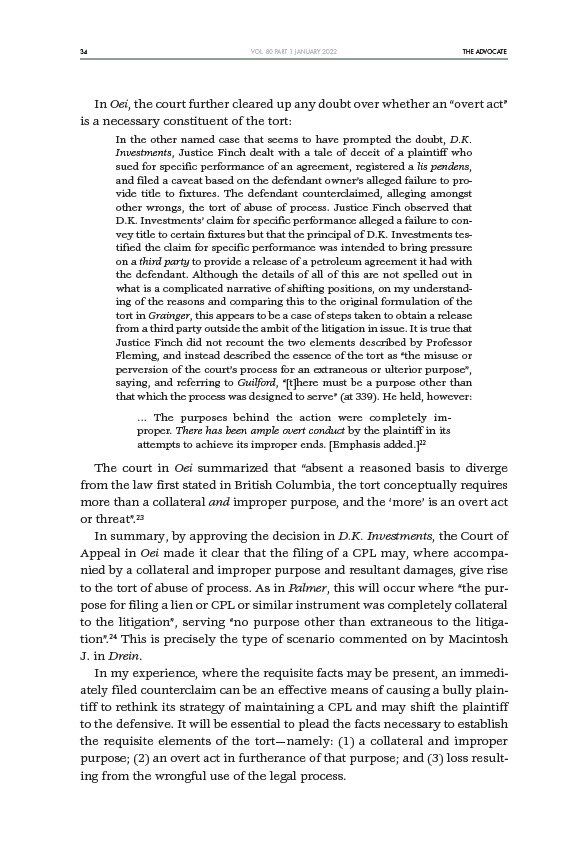
34 THE ADVOCATE
VOL. 80 PART 1 JANUARY 2022
In Oei, the court further cleared up any doubt over whether an “overt act”
is a necessary constituent of the tort:
In the other named case that seems to have prompted the doubt, D.K.
Investments, Justice Finch dealt with a tale of deceit of a plaintiff who
sued for specific performance of an agreement, registered a lis pendens,
and filed a caveat based on the defendant owner’s alleged failure to provide
title to fixtures. The defendant counterclaimed, alleging amongst
other wrongs, the tort of abuse of process. Justice Finch observed that
D.K. Investments’ claim for specific performance alleged a failure to convey
title to certain fixtures but that the principal of D.K. Investments testified
the claim for specific performance was intended to bring pressure
on a third party to provide a release of a petroleum agreement it had with
the defendant. Although the details of all of this are not spelled out in
what is a complicated narrative of shifting positions, on my understanding
of the reasons and comparing this to the original formulation of the
tort in Grainger, this appears to be a case of steps taken to obtain a release
from a third party outside the ambit of the litigation in issue. It is true that
Justice Finch did not recount the two elements described by Professor
Fleming, and instead described the essence of the tort as “the misuse or
perversion of the court’s process for an extraneous or ulterior purpose”,
saying, and referring to Guilford, “there must be a purpose other than
that which the process was designed to serve” (at 339). He held, however:
… The purposes behind the action were completely improper.
There has been ample overt conduct by the plaintiff in its
attempts to achieve its improper ends. Emphasis added.22
The court in Oei summarized that “absent a reasoned basis to diverge
from the law first stated in British Columbia, the tort conceptually requires
more than a collateral and improper purpose, and the ‘more’ is an overt act
or threat”.23
In summary, by approving the decision in D.K. Investments, the Court of
Appeal in Oei made it clear that the filing of a CPL may, where accompanied
by a collateral and improper purpose and resultant damages, give rise
to the tort of abuse of process. As in Palmer, this will occur where “the purpose
for filing a lien or CPL or similar instrument was completely collateral
to the litigation”, serving “no purpose other than extraneous to the litigation”.
24 This is precisely the type of scenario commented on by Macintosh
J. in Drein.
In my experience, where the requisite facts may be present, an immediately
filed counterclaim can be an effective means of causing a bully plaintiff
to rethink its strategy of maintaining a CPL and may shift the plaintiff
to the defensive. It will be essential to plead the facts necessary to establish
the requisite elements of the tort—namely: (1) a collateral and improper
purpose; (2) an overt act in furtherance of that purpose; and (3) loss resulting
from the wrongful use of the legal process.